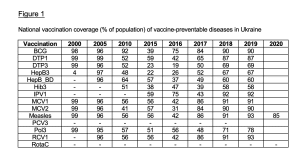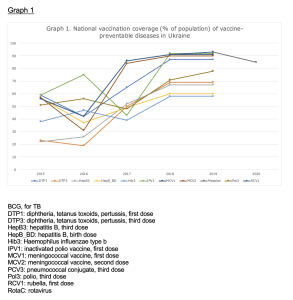 Richard Armitage is a GP and Public Health Specialty Registrar, and Honorary Assistant Professor at the University of Nottingham’s Academic Unit of Population and Lifespan Sciences. He is currently providing primary care to internally displaced people in the east of Ukraine. He is on twitter: @drricharmitage
Richard Armitage is a GP and Public Health Specialty Registrar, and Honorary Assistant Professor at the University of Nottingham’s Academic Unit of Population and Lifespan Sciences. He is currently providing primary care to internally displaced people in the east of Ukraine. He is on twitter: @drricharmitage
While rates of multidrug-resistant tuberculosis and other communicable diseases in Ukraine are among the highest in the WHO European Region,1 the country’s vaccination rates against vaccine-preventable diseases are concerning low. Now, both are being compounded by the Russian invasion.
Although national vaccine campaigns have substantially reversed the decline in vaccination rates triggered by the outbreak of conflict in eastern Ukraine in 2014,1,2 the country still had the lowest coverage rates for all vaccinations among WHO European Region Member States in January 2019 (see Figure 1).1 This insufficient performance was driven by supply chain difficulties, public vaccine hesitancy, and inadequate health workforce training, and hinders national progress towards the health-related Sustainable Development Goals, specifically SDG 3.8 regarding Universal Health Coverage including ubiquitous access to essential vaccines.1
…the country still had the lowest coverage rates for all vaccinations among WHO European Region Member States in January 2019
A disturbing consequence of this low vaccination coverage is the incidence of measles in Ukraine, which amounted to 110,500 cases in 2018 and 2019 (52.7% of all cases reported in the WHO European Region in that period), and 1,302 cases per million population in 2019 (more than 10 times the incidence for the Region).1 Latest data from 2020 reveal that only 85% of children in Ukraine are vaccinated against measles, substantially below the 93-95% herd immunity threshold.2 Today, the risk of measles and other communicable disease outbreaks is deeply compounded by the on-going war.3
The resulting conditions of low vaccination coverage, mass human migration, and transmission-promoting living arrangements render outbreaks of vaccine-preventable diseases increasingly probable.
Beginning on 24 February 2022, the Russian invasion has interrupted the delivery of Ukraine’s childhood vaccination schedule through the destruction of healthcare infrastructure and supply chains,4 the evacuation of healthcare workers from embattled areas, and the mass migration of people to neighbouring countries or the relative safety of adjacent Oblasts. Accordingly, many children born during or prior to the conflict remain unvaccinated and therefore vulnerable to vaccine-preventable diseases.5 In addition, despite reporting its highest daily number of new confirmed COVID-19 cases on 10 February 2022, Ukraine has reported no daily new confirmed COVID-19 case data since 03 March 2022, and no new daily COVID-19 vaccination data since 27 February 2022 (at which time only 36.3% of those eligible had received at least one dose),6 suggesting high rates of COVID-19 transmission are on-going in Ukraine while vaccination uptake has stalled. Concurrently, thousands of Ukrainians, including individuals at the extremes of age and those with the greatest burden of disease,7 shelter from Russian aggression in damp, unventilated, and overcrowded basements, driving dehydration and malnutrition, and poor sanitation and hygiene. Such densely populated environments also occur in the temporary evacuee centres now accommodating many of the 7.7 million internally displaced people within Ukraine.8 The resulting conditions of low vaccination coverage, mass human migration, and transmission-promoting living arrangements render outbreaks of vaccine-preventable diseases increasingly probable.
For as long as the war continues, Ukraine’s low vaccination coverage will continue to deteriorate and exacerbate its existing high rates of vaccine-preventable diseases. Action by the global health community is urgently required to prevent this double injustice.
References
- World Health Organization Regional Office for Europe. Towards a healthier Ukraine: progress on the health-related Sustainable Development Goals 2020. 2020. https://www.euro.who.int/en/countries/ukraine/publications/towards-a-healthier-ukraine-progress-on-the-health-related-sustainable-development-goals-2020 [accessed 15 May 2022]
- World Health Organization Regional Office for Europe. Ukraine: Synergistic Health In Emergencies Ladder Development Scale (SHIELDS). https://gateway.euro.who.int/en/country-profiles/ukraine/#Vaccination-coverage [accessed 15 May 2022]
- World Health Organization Regional Office for Europe. Ukraine: Immediate steps needed to prevent a measles outbreak due to the ongoing war and low vaccination rates, warns WHO. 28 April 2022. https://www.euro.who.int/en/media-centre/sections/press-releases/2022/ukraine-immediate-steps-needed-to-prevent-a-measles-outbreak-due-to-the-ongoing-war-and-low-vaccination-rates,-warns-who [accessed 15 May 2022]
- L Taylor. Russian forces are increasingly targeting Ukrainian healthcare facilities, says WHO. BMJ 25 March 2022; 376: o801. DOI: 10.1136/bmj.o801
Featured image by Olga Subach on Unsplash






